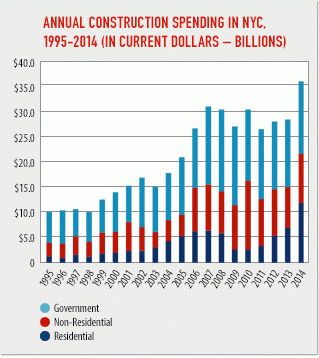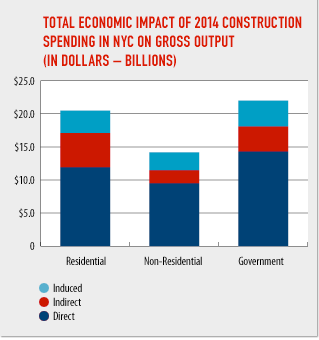
NYC construction spending reached $36 billion in 2014; a 26 percent increase from 2013
Construction Activity Yielded $57 Billion in Total Economic Impact for the City
Overall construction spending in New York City reached $36.0 billion in 2014, a 26 percent increase from 2013, when total spending reached $28.5 billion, according to a New York Building Congress analysis.
Construction employment in New York City reached 122,975 jobs in 2014, an increase of slightly more than 2,000 jobs from the prior year and the highest total since 2008, when the industry employed 132,625 workers.
Residential
Residential construction spending skyrocketed to $11.9 billion in 2014 – a 73 percent increase from the previous year. Not only is this a record (even after factoring for inflation), but it is the first time in New York City history that annual residential spending has even topped $7 billion.
That said, the percentage increase in unit production is not currently keeping pace with the increased spending. The 20,329 new units produced in 2014 represent just an 11 percent increase from the prior year and remain well below the more than 30,000 units of new housing that were created annually between 2005 and 2008.
Government
Government construction spending, which includes investments in mass transit, public schools, roads, bridges, and other essential infrastructure, increased 7 percent – from $13.4 billion in 2013 to $14.3 billion in 2014. Government spending peaked at $16.3 billion in 2008 and has remained in the $13-14 billion range over the past four years.
Non-Residential
Non-residential construction, which includes office space, institutional development, sports/entertainment venues, and hotels, climbed 20 percent – from $8.2 billion in 2013 to $9.8 billion in 2014. This marks the first time since 2010 that non-residential spending increased from the prior year. With multiple Hudson Yards towers now under construction as well as the full-scale resumption of work on 3 World Trade Center, the near-term prospects for the commercial sector remain bright.
“While the unprecedented boom in residential construction is justifiably grabbing the headlines, what’s most encouraging about 2014 is the growing strength exhibited in all three sectors of the construction market,” said New York Building Congress President Richard T. Anderson. “As an industry, we must ensure that we have the capacity to conduct all this work efficiently and safely while also collaborating with government to promote continued public and private sector investment throughout the five boroughs.”
Economic Impact
The $36 billion in direct construction spending in New York City stimulated an additional $21 billion in total spending in other sectors of the City’s economy – for a total economic output of $57 billion. This represents a multiplier effect of $1.58, as each dollar spent on construction yielded an additional $.58 in overall economic activity.
The additional $21 billion can be broken into two categories – the indirect and the induced effect. The indirect effect, which consists of output generated by businesses that serve the construction industry, amounted to $10.9 billion in 2014, while the induced effect, which represents the consumption spending of workers employed by the construction and support services, amounted to $10.1 billion.
The Gross City Product (GCP), or total value added, was $31.6 billion as a result of the total economic effect. This represents 4 percent of New York’s $762 billon GCP in 2014. By sector, government construction spending contributed 2 percent to the GCP while residential and non-residential each contributed 1 percent.
Along with government, residential, and non-residential construction, the other major sectors of the City’s economy that benefited from the $57 billion in spending included wholesale trade, real estate, and retail, as well as architecture, engineering, and related services.
In addition to direct construction employment, last year’s construction activity produced another 130,000 jobs throughout New York City’s economy. Nearly 67,000 jobs were created in fields that service the construction industry, such as lawyers, accountants, and suppliers. Still another 63,000 jobs were induced by the increased household earnings that resulted from direct construction and the related expansion of economic activity. The annual average salary for all direct, indirect, and induced employment was $83,250.
“There simply is no overestimating how important the construction industry is to New York City, especially once you factor in the ripple effect throughout the City’s economy,” added Mr. Anderson. “This is something that we need to keep in mind as the debate heats up in Albany regarding the MTA’s capital program and incentive programs such as 421-a. In addition to paving the way for continued growth, these programs also stimulate the economy in the near-term by providing stable sources of jobs, income, and spending.”Dodge data used for this analysis can be purchased at dodge.construction.com.
Charts and Diagrams

Sources: Dodge Data & Analytics, Public Agency Capital Budgets/Plans, & Urbanomics

Sources: Implan Pro Model for NYC & Urbanomics



